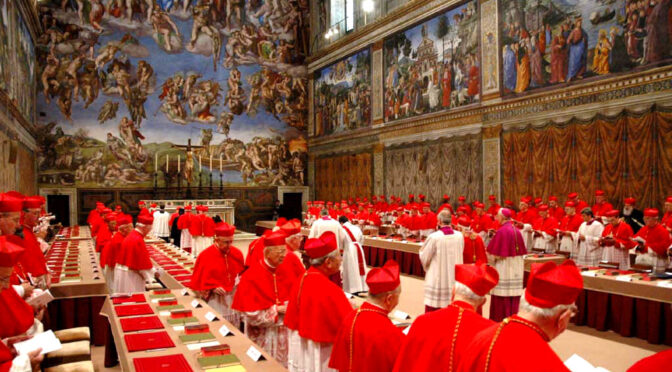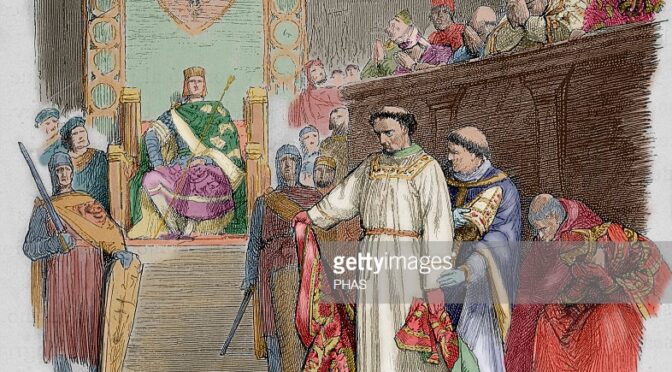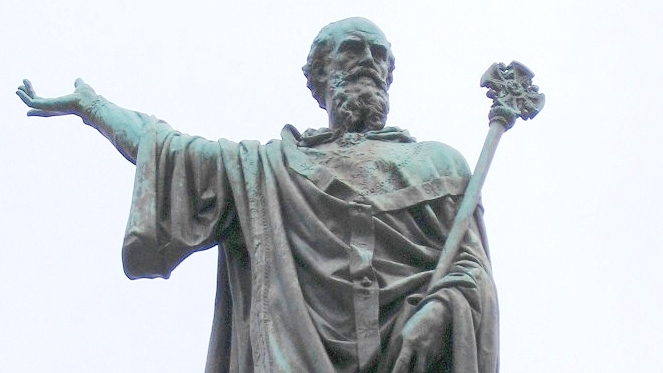A SUMMARY OF CANONICAL HORRORS AND MONSTROSITIES
by Br. Alexis Bugnolo
With the news of Pope Francis’ health always declining further (see here, here, here, and here), with no less than the popular ex-FOX News host, Judge Napolitano, saying last spring that Pope Francis was moribund, the speculation and anxiety of Catholics the world-over is at an all time high, regarding the next Papal Conclave and its outcome.
The tradition of the Conclave arose in the 13th century, when Cardinals gathering to vote for the Pope, at Viterbo, refused to come to a mutual agreement and spent months on end in negotiations, to the dismay not only of the Catholic world, but of the Mayor of the City, who locked them up and put them on bread and water rations to hasten the outcome. But the rules limited the vote to Cardinals comes from the Papal Law, In Nomine Domini, of Pope Nicholas III, in 1059, when after generations of conflicts among the prominent noble families of central Italy and Rome, he chose to remove the right of election from the general assembly of all the Faithful of the Roman Church, and restrict it only to hand selected clergymen.
The anxiety of Catholics arises from the fact that of the more than 250 Cardinals, only 30 were nominated by Popes John Paul II or Benedict XVI, and of those 30, there is strong evidence to show that 11 of them voted for Jorge Mario Bergoglio in the faux conclave of 2013, when they proceeded to elect a new pope even though the previous had not renounced the petrine munus. For more about that see, the Index to Pope Benedict XVI’s Renunciation and the Chronology of Reports on Team Bergoglio, which latter details the published evidence that a group of Cardinals conspired in violation of the papal law to canvass for votes. These two articles represent the most authoritative and complete collection of links and articles regarding the canonical debates on both topics; and they are read by nearly all the journalists writing on the topic, though they refuse to cite them as sources. So its worth your while to read them yourself, for 99% of the real news about the Catholic Church is never publicly reported.
Adding to this anxiety is that Pope Francis, having impeded the Apostolic See by a heretical profession when he signed ‘Fiducia supplicans’ in December of 2023, he has proceeded to name 21 new Cardinals, the majority of which have publicly professed the same heresy. These 21 Cardinals will be installed on December 8, 2024, at the Vatican in an official ceremony.
So there is frequent consternation and lamentation about the outcome of the next conclave, with many catholic writers throwing up their hands in despair, that the next Pope will even be a Catholic. For if he is not, then he cannot be the pope and will be an antipope.
The next Conclave is overshadowed by the gravest of doubts
While it is true that the laws of the Church allow any male celibate over the age of maturity to be elected the Roman Pontiff, it has been long time since a non-Cardinal was elected to the Apostolic Throne. In fact, it was Pope Urban VI in 1378, who was the last non-Cardinal so elected, and his election was shortly thereafter contested by the Frenchmen who were cardinals, who to the horror of the Catholic world proceeded to elect an antipope to rival him, and installed him at Avignon, thus beginning the Great Schism in the West, which would last until 1415 A. D..
So while it is still possible for the College of Cardinals to elect a non-Cardinal, it is scarcely likely.
Which means there is a 90% chance that the next Pope will be a man made a Cardinal by Pope Francis.
And that is the source of the anxiety. Because faithful Catholics who have been paying attention to the utterances of Jorge Mario Bergoglio are already convinced he is not a Catholic, even if they won’t openly call him a heretic.
And the heretical depravity of Pope Francis is so notorious, that clergy who publicly declare it are immediately punished with the most severe canonical procedures such as reduction to the lay-state or excommunication. There is no room for dissent in the heretical coven of Pope Francis.
Add to this the high level of doubt most Catholics have, that Pope Francis was never canonically elected, or even elected in a juridically valid manner — just to speak of those who still walk in opinions and have not examined the evidence and/or do not possess the intellectual formation necessary to discern any clear answer to such questions.
5 Ways the Next Conclave may give us another antipope
And for that reason, I would like to review in this article, the 5 ways the next Conclave may give us, not a successor of Saint Peter, but a destroyer of souls, a False Prophet, the Antichrist or simply an antipope.
1. What if the Conclave professes heresy before the election?
Conclaves never make public announcements before they elect a pope. Or at least that was the longstanding tradition until the faux conclave of 2013, where they interrupted their proceedings to issue a public condolence for the passing of the Marxist Dictator and murderous Tyrant of Venezuela, for no particular reason at all. Catholics upon hearing of this in March of 2013 shuddered, because the knew that it forebode the election of a corrupt marxist. And they were right.
So if the Conclave publicly endorse the acts of Pope Francis during his antipapacy or his heretical statements such as ‘Fiducia supplicans’ or his teaching in ‘Amoris laetitia’ which contradicted Apostolic Tradition, then Catholics will have the most sold canonical evidence that the Conclave has apostatized from the Catholic Faith and that the man they elect is an antipope and heretic himself, to be owned no obedience, submission or respect by the entire Catholic world — unless of course he immediately repudiates their public statement during the Conclave.
In the case of such a heretical profession by the College of Cardinals, Catholics from Rome, will have to again convene in general Assembly according to Apostolic Right and elect a true Successor of Saint Peter. I have explained this at length in numerous articles regarding the election of January 30, 2023. But in this case, they will have the right to do so, immediately with the heretical profession being publicized; that, is even while the Conclave remains in session and has no yet elected a candidate, since the public declaration by the College is sufficient canonical proof of apostasy, just as the one in 2013 was.
2. What if the Cardinals hold a conclave while Pope Francis is terminally incapacitated?
Next, since it is now a popular and current opinion among the supporters of Pope Francis, that a pope is impeded if he falls into a coma — so much so that they held a conference about the matter a few years ago — and that in such circumstances Vatican officials have the juridical capacity to judge that he has lost his office, it is highly likely that Pope Francis might still be alive when the next Conclave is convened.
In such a case, the election will be invalid, and the one elected another antipope. And the Catholics of Rome will have to await the death of Pope Francis, before they can exert their Apostolic Right to elect a valid successor.
3. What if the Cardinals hold a conclave after Pope Francis invalidly resigns?
Again, since those who support Pope Francis hold the erroneous opinion that a pope can abdicate by resigning the petrine ministerium, only, it could happen that they persuade Pope Francis to renounce like Pope Benedict XVI and thus fail to do so canonically, giving the appearance of a true abdication, but without any canonical validity to the act.
If they proceed into Conclave under such circumstances, the election will be invalid, and the one elected another antipope, just as happened in February-March 2013, with Pope Benedict XVI.
In such a case, again, the Catholics of Rome will have to await the death or valid resignation of Pope Francis, before they can exert their Apostolic Right to elect a valid successor.
4. What if the Cardinals hold a conclave to revolt against Pope Francis?
Again, since the obnoxiousness of Pope Francis is already at apocalyptic levels, it could happen that some, a majority or even all of the Cardinals eligible to vote, renounce Pope Francis and hold a conclave to elect a successor to Pope Benedict XVI or to Pope Francis.
In such a case, since Pope Francis was elected in a juridically valid manner by Apostolic Right on January 20, 2023 A. D., such a Conclave will result in another antipope being elected.
In such a case, again, the Catholics of Rome will have to await the death of Pope Francis, before they can exert their Apostolic Right to elect a valid successor, if no Cardinals convene at that time to elect one.
5. What if the Cardinals hold a conclave and elect someone ineligible to be the Pope?
Finally, to round out the possible nightmarish scenarios, what if the next Conclave, after Pope Francis’ death or valid abdication, would elect an hermaphrodite, or a transgendered or a woman or a trans-human, with AI implants? Or what if they elect an non-Catholic, such as the Anglican Archbishop of Canterbury, the Russian Orthodox Patriarch, or an Evangelical Preacher, or Bill Gates? or someone already canonically excommunicated? Or someone who is married to a woman or a man, civilly or not, or a siamese twin still connected to his twin brother etc..
In such a case the election would be invalid and the one elected another antipope, of the most monstrous kind. And the Catholics of Rome will have to exert their Apostolic Right to elect a valid successor, immediately upon knowing of the invalidity of the person elected.
+ + +
For more information about how the Faithful of Rome (all the baptized regardless of their station in life) have the right to elect a pope, when the College of Cardinals fails to do their duty, see here.
I have not considered the cases of unworthy men who could be elected, like a flagrant sodomite, pedophile, murderer, government agent, or even manifest but not-yet excommunicated Catholics who are manifest heretics etc.., because there is presently no law in the Church to prevent such men from being elected, strange to say and even more sadly to admit.
I have also not included the case, like that in 1378, in which part of the Cardinals after a valid election, enter into a second Conclave because they refuse the first. In addition, I have not included cases where there is such dissension among the Cardinals, that in the first Conclave they split into two groups and rush to announce the election of two popes nearly simultaneously or simultaneously, thus making it impossible to determine who is the valid pope or not.
Finally, I publish this now, so that, God Forbid!, if any one of these outcomes comes to pass, no one will be able to claim that I have invented rules to suit the circumstances; and so that all who side the the next antipope can be seen for what they really are.





 He took the name Urban II, recalling the Saint and Martyr by that name who reigned on the See of Peter at the beginning of the Third Century.
He took the name Urban II, recalling the Saint and Martyr by that name who reigned on the See of Peter at the beginning of the Third Century.